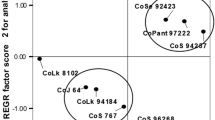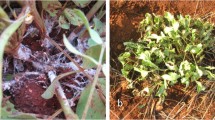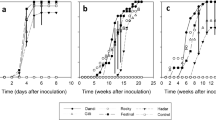Abstract
Studies on the resistance to top borer (S. nivella) in sugarcane varieties were made in the plant and ratoon crops. Eight varieties, namely, P. 12235, Co. 1007, Co. 1107, Co. 1148, Co. 1328, G. 12061, CoJ.46 and CoL.9 were grown in 4 replications of 6 rows of 30 meters each. Samples of stalks were taken from 5.0 per cent row length and also four samples of 10 stalks each under the graded incidence of 0, 10, 20, 30, 40, 50, 60, 70, 80, 90 and 100.0 per cent from, 400 stalks, cut at random and pooled, in each variety. It turned out that CoL.9 hitherto considered as a susceptible variety towards the top borer, obtained the overall rated value 1, having the least total loss for the sum of characters (stalk length, number of internodes, girth, weight, sucrose and C.C.S.). It was suggested that in top borer endemic areas CoL.9 and P.12235 may be preferred both as plant and ratoon crops.
Simple and partial correlations worked out between the per cent of incidence and different loss characters showed that there existed a positive and significant relation between them. The regression coefficient showed a linear relationship between them. The regression equations were also worked out. It was found that from the incidence values alone the relative amount of losses caused in different varieties by the top borer could be confidently predicted.
It was concluded that the sugarcane varieties could be screened for resistance to top borer simply by recording the percentage of borer incidence.
Résumé
L’étude de la résistance àS. nivella de variétés de canne à été faite dans des champs de plants et de repousses. Huit variétés ont été cultivées en 4 répétitions de 6 rangs de 30 mètres chacun. Pour chaque variété des échantillons de tiges furent prélevés sur 5% de la longuer du rang ainsi que 4 échantillons de 10 tiges, chacun selon une échelle progressive de 10 en 10% allant de 0 à 100% pour 4000 tiges coupées au hasard et mises ensemble. Il en ressort que la variété Col. 9 considérée jusqu’à présent comme sensible au foreur, a obtenu la valeur maximum de 1 correspondant aux pertes totales les plus faibles pour la somme des caractères: longueur de la tige, nombre d’internœuds, circonférence, poids, teneur en sucrose et en C.C.S. Il est proposé que dans les régions où le foreur est endémique les variétés Col. 9 et P. 12235 soient préférées pour les champs de plants et ceux de repousses.
Les corrélations simples et partielles établies entre le pourcentage d’attaques et les différents critères de pertes montrent qu’il existe entre eux une relation positive et significative, avec un coefficient de régression correspondant à une droite. Il apparaît que d’après les seuls degrés d’attaque il est possible de prévoir avec assurance les taux relatifs des pertes provoquées par le foreur chez les différentes variétés.
On en conclut que les variétés de canne à sucre peuvent être choisies pour leur résistance au foreur simplement par la notation du pourcentage d’attaques.
Similar content being viewed by others
References
Adlaka, P. A. — 1964. Studies of the various factors responsible for resistance to top borer in different varieties of sugarcane. —Ind. jour. Sug. Cane Res. Dev.,8, 343–344.
Agarwal, R. A. &Siddiqui, Z. A. — 1964. Sugarcane pests. Entomology in India. —Ent. Soc. Ind.,10, 149–186.
Agarwal, S. B. D. &Prasad, S. K. — 1956. The status of sugarcane top borer in Bihar. —Indian Sugar,6, 60–66.
Doss, S. V. J. — 1954 The top shoot borer, in the factory zone in South Arcot District Madras State. —Proc. Conf. Sug. Res. Dev. Wrk. India,2, 151–155.
Gupta, B. D. — 1953. Resume of work done in India under the Insect Pest Scheme during 1946–47 to 1950–51, New Delhi. —Publ. Ind. Central Sug. Comm, 111.
— — 1959. Insect pests of sugarcane in India. III The top borer (Scirpophaga nivella F.). —Indian Sugar,3, 127–149.
Hart, P. C. — 1932. Top borer attack in relation to hardness of growing point of POJ 2878. —Arch. Suiker Nederlands Indië,40, 15.
Hayes, H. K., Immer, F. R. &Smith, D. C. — 1942. Methods of plant breeding.McGraw Hill, London, 548.
Hazelhoff, E. H. — 1929. Determining the damage done to sugarcane in Java by the top-borer and the stripped stalk borer. —Proc. 3rd Cong., I.S.S.C.T., 168.
— — 1930. The cane tip borerScirpoghaga intacta. (Rev. appl. Ent.,18 (A) 703).
Hazelhoff, E. H. — 1932. Investigations on white tip borer. —Proc. 4th Cong. I.S.S.C.T., 169.
Issac, P. V. — 1939. How midrib hardness effect resistance to surgarcane top borer (Scirpophaga nivella F.). —Curr. Sci.,8, 211–212.
Jepson, W. F. — 1954. A critical review of the world literature on the Lepidopterous stalk borers of tropical graminaceous crops. —London Commonwealth Inst. Ent., 127.
Kalra, A. N. &Sidhu, A. S. — 1960. Chemical control of sugarcane top borer (Scirpophaga nivella F.). —Ind. jour. Sug. Cane Res. Dev.,1, 36–47.
Kalra, A. N. &Chaudhry, J. P. — 1964. Assessment of losses by sugacane pests, loss caused by top borer of sugarcane. —Ind. jour. Sug. Cane Res. Dev.,8, 261–264.
Khanna K. L. &Ramanathan, K. R. — 1964. Studies in association of plant characters and pest incidence. II. On the relationship between spindle length and varietal resistance to top borer attack to sugarcane. —Ind. Jour. Ent.,8, 178–185.
Khanna, K. L. &Bandyopadhyaya, K. S. — 1951. Studies in sampling technique. Estimation of borer incidence in sugarcane. —Proc. ind. Acad. Sci.,34, 210–219.
Lee, M. S. &Chieu, C. H. — 1961. Preliminary observations both on ecology and morphology of the egg parasite of top borer in the surgarcane. —Rep. Taiwan Sug. Exp. Stn.,23, 101–116.
Panse, V. G. &Sukhatme, P. V. — 1961. Statistical methods for agricultural workers. —Publ. Indian Council agric. Res., New Delhi, 366.
Pradhan, S. &Prasad, S. K. — 1953. Studies on the distribution and sampling of insect pests. —Proc. ind. Sci. Congr.,46, 150.
Rao, J. T. — 1941. Hard leaf midrib in surgarcane and resistance to top borer (Scirpophaga nivella F.). —Curr. Sci.,10, 171.
— — 1947. Leaf midrib structure of sugarcane as correlated with resistance to top borer (Scirpophaga nivella F.) —Ind. Jour. Agri. Sci.,17, 203–210.
Rider, P. R. — 1939. An introduction to modern statistical methods. —John Isley and Sons. New York, pp. 220.
Siddiqui, Z. A. — 1961. Estimation of losses due to sugarcane borers. —Proc. Conf. Sug. Res. Dev. Wrk. India,4, 541–546.
Venkatraman, T. V. — 1962. Varietal behaviour on yield and quality of top borer affected canes. —Ind. Jour. Sug. Cane Res. Dev.,6, 43–46.
Verma, S. C. &Mathur, P. S. — 1950. The epidermal characters of sugarcane leaf in relation to insect pests. —Ind. Jour. Agri. Sci.,20, 387–390.
Author information
Authors and Affiliations
Rights and permissions
About this article
Cite this article
Agarwal, R.A., Singh, J.P. & Tiwari, C.B. Technique for screening of sugarcane varieties resistant to top borer,Scirpophaga nivella F.. Entomophaga 16, 209–220 (1971). https://doi.org/10.1007/BF02371171
Issue Date:
DOI: https://doi.org/10.1007/BF02371171




